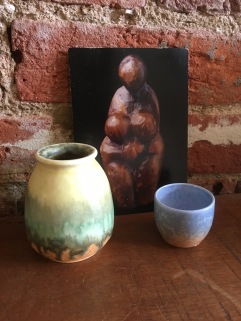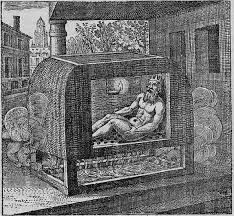Containers are an archetypal structure. They feature an inside, an outside, and something between the two. Material can be held within the container, and some containers are designed to be transformative for that substance (the womb, the stomach, the alchemical flask, the therapy relationship).
Leaky containers are useless. This is why we focus so much in therapy on boundaries, the boundaries are the ‘walls’ of the container, it is how the container is made. We focus on sealing the container so that the work can proceed
 But what about oppressive containers? A prison is a container, quite an effective one, but it only becomes a transformative space when the inmate, the prisoner, says ‘yes’ to it, and allows the limitations to teach something. This is an interesting observation – and it certainly appertains to therapy. Consent to be in the container is vital to the process of it becoming a transformative space. This raises interesting questions about how trainee psychotherapists (who are required to have extensive psychotherapy as part of their training) can best use the therapeutic space. Until the person who is obliged to be there really gets a ‘yes’ to being there, the therapy will probably be ineffective, regardless of any other factors. We have to say yes to it.
But what about oppressive containers? A prison is a container, quite an effective one, but it only becomes a transformative space when the inmate, the prisoner, says ‘yes’ to it, and allows the limitations to teach something. This is an interesting observation – and it certainly appertains to therapy. Consent to be in the container is vital to the process of it becoming a transformative space. This raises interesting questions about how trainee psychotherapists (who are required to have extensive psychotherapy as part of their training) can best use the therapeutic space. Until the person who is obliged to be there really gets a ‘yes’ to being there, the therapy will probably be ineffective, regardless of any other factors. We have to say yes to it.
This is seen in the Christian story of the annunciation as well, in a slightly different form. In this story, Mary is visited by Gabriel, the angel of news, guidance, insight. He tells her that she will bare a child (one of of reading this is that she will transform, i.e. something (the divine) will be born in her…..) but note that in the story she has the choice. She says yes ‘Be it unto me according to Thy will’. She consents, and so she can become the container. This theme of consent to the archetype of the container is a rich vein of ore.
Part of the reason this theme of consent is so important for the archetype of the container is that discomfort is so often part of the experience. In therapy we see this as the heat turns up, and our client begins to burn in their calcinatio process, or feels as if they are dissolving and falling apart in the solutio. Containers may be uncomfortable, and yet beneficial, like a sauna. In this image from Michael Maiers Atlanta Fugiens the King is sweating in the sweatbox – he is being purified. There is
 great value in sitting with something, when we do not know what the answer is. This is why the therapy and supervision containers are so important. We can be present to the material and allow it to reveal itself to us.
great value in sitting with something, when we do not know what the answer is. This is why the therapy and supervision containers are so important. We can be present to the material and allow it to reveal itself to us.
Challenging a boundary in therapy is very much a part of the therapeutic process, and we welcome it when it happens. It is a chance to make conscious the discomfort of sitting in side the closed box. The discomfort will help the person. It will be the very agony they are trying to avoid. But of course it is uncomfortable and can bring up fear, injustice, confinement. Going through a psycho-spiritual transformation is devastatingly hard work, and the therapist often has little to offer but their capacity to keep a lid on the pressure cooker, and observe the cooking with compassion, companionship, empathy and love. Like pregnancy, we have to trust the process, and wait.

Very insightful. Thank you!
As Rumi says:
After all your troubles are your treasure; Alas you, yourself are a cover on your own treasure. Translation by me!!
Sent from my iPad
>
LikeLiked by 1 person
And again Rumi says,
I was raw I was cooked Now I am burnt
Sent from my iPad
>
LikeLiked by 1 person
Reblogged this on helenjnoble.
LikeLike
Thank you Helen that is great! Glad you like the post.
LikeLike
You’re welcome. I am enjoying all of your blogs.
LikeLike